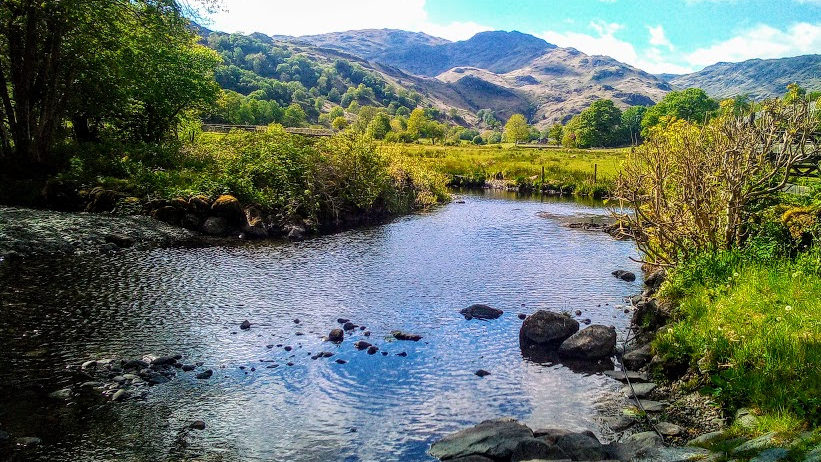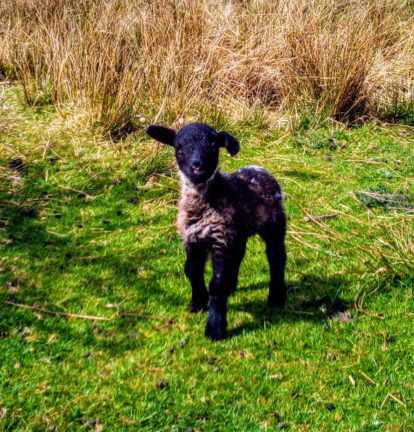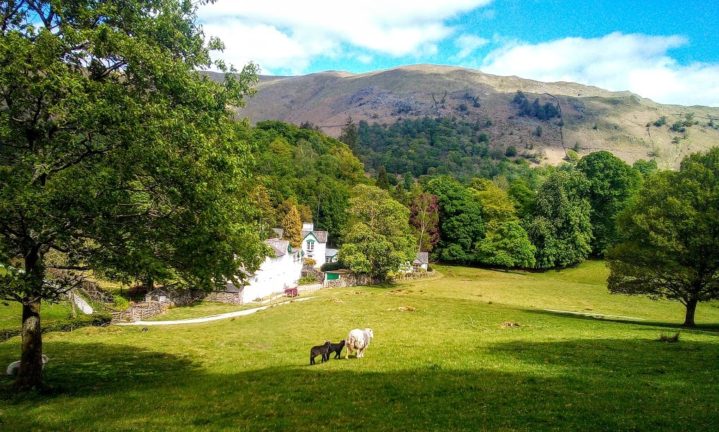
This story was adapted from an email distributed by Terry Winterton, the Friend in Residence at Glenthorne’s guest house in Grasmere, Great Britain. Anyone who has read William Wordsworth will know that the walks, hillsides, and lakes in this region were powerful sources of inspiration for Wordsworth’s poetry. They also charm Quaker travelers seeking to access Pendle Hill, Swarthmore Hall, and the rural country roads and fells (mountains and hills) walked by George Fox in 1652. All are featured in this short film. (Interested educators can teach this history to children though Faith & Play Stories on George Fox and Margaret Fell.) The region also serves international hikers and nature lovers from around the world.
By Terry Winterton
I took this photo of Easedale Beck (brook) on May 12 at the ford by the single file footbridge that crosses the beck from Easedale road. It looks north towards Sour Milk Ghyll (falls) and the hollow that holds Easedale Tarn. You can usually pick out the white waterfalls of the ghyll very easily but we have had so little rain over the Covid lockdown that the falls are much diminished at the moment.
The days seem to pass quickly here and it is hard to believe that it has been over seven weeks (23 March) since our distancing restrictions began. Our last newsletter featured a picture of the Herwick sheep in the field by Glenthorne as they were rounded up by the shepherd and his dogs to take them to the safety of the farm.
 Last week they were brought back, accompanied by their newly born black lambs, many of them twins! We often watch them over breakfast as the lambs bounce up and down for joy together. That’s not the only thing that’s back; we’ve heard our first cuckoo of the year and since then we have been hearing them clearly every day, at least three (seem to live) around Grasmere! With less background noise at the moment we are now able to hear the delicate chimes of St Oswald’s clock tower in the village. The delightful notes are carried across the fields from three bells that ring on the hour and at every quarter.
Last week they were brought back, accompanied by their newly born black lambs, many of them twins! We often watch them over breakfast as the lambs bounce up and down for joy together. That’s not the only thing that’s back; we’ve heard our first cuckoo of the year and since then we have been hearing them clearly every day, at least three (seem to live) around Grasmere! With less background noise at the moment we are now able to hear the delicate chimes of St Oswald’s clock tower in the village. The delightful notes are carried across the fields from three bells that ring on the hour and at every quarter.
In this quiet time we are putting together the Special Interest Holiday brochure for 2021. At the moment we have arranged thirty three weekends and mid week courses/holidays. These include regular courses such as circle dancing, painting and sketching, yoga, mindfulness, creative writing, spiritual well being, singing and others of particular interest to Quakers such as Rex Ambler’s Living in Dark Times with William Penn, Roswitha Jarman’s Martin Buber in Practice and Jan Arriens Living in the Mystery.
A number of people have shared poems with me by email as a result of ministry in this small online community. Here is one:
Was it Coincidence?
Was it coincidence that the blackbird came?
Or could I know
That God would do the same
For me, as long ago
He did for those whose need was great?
So great, they felt they could not wait
To see his sign?
God sent his sign,Could this be mine?
Gently to his accustomed perch he flew.
He did not tell me “I have come for you ”
Perhaps he did not know,
But then, I knew
The poem was sent by Julia Richardson from Newark and written by her friend, Margaret McNeill, a resident of Avenue House (a Quaker Home) in the 1980s.
I expect most of us have experienced coincidences at difficult or significant times. Our current popular culture dismisses them as superstitious, but it is my experience that we diminish the meaning in our life if we discount such encounters or occurrences. Carl Jung called them meaningful coincidences, to distinguish them from the everyday ones. Several Friends have shared their experiences of such events, often from momentous times in their life. Often they can involve encounters with animals or birds.
It was to allow us to become more aware of our more meaningful connections with the natural world that Margaret Calvert and I started the Encounters with the Divine in Nature retreat here at Glenthorne. I have also certainly experienced some very meaningful coincidences at big change points in my life, not least when I started at Glenthorne as the Friend in Residence exactly seven years ago.
Legendary stories of strange coincidences are often associated with Holy places. George Macleod (1), the founder of the Iona community in Scotland recounted events surrounding the building of the community. Restoration work on the building had stopped because a stone mason was needed. A passing visitor on a walking holiday happened to be a Master Stonemason! They volunteered their services. In another incident, when the refectory needed a roof, a consignment of suitable timber washed up on the beach apparently jettisoned by a cargo ship in trouble. It is reported on such occasions George would say, ‘If you call that a coincidence, then I wish you a very dull life.’*
Terry writes that Glenthorne looks forward to happy coincidences and special times–of meeting old friends and making new ones–during Friends’ visits to Glenthorne in the future. He hopes to see some of our readers as travelers once they re-open for guests.
To inquire about online worship or re-opening: info@glenthorne.org
*Sources: Ron Ferguson. George MacLeod: Founder of the Iona Community. Wild Goose publications 20012 & Harvey Gilman. Words. p49. The Friends Publication Limited 2016
Educational Resources on George Fox and Margaret Fell
Interested in a resource to share about 1652 Country and early Friends with children? Inspired by “Flat Stanley,” our friends at Faith & Play Stories sent “Flat” George Fox and Margaret Fell on a pilgrimage to walk in their own footsteps. Images in the movie and slideshow allow children to visit important places from early Quaker history, some where Friends still gather and worship today. Share the accompanying lesson plan and encourage young people to cut out their own Flat Fox and Fell to document and share with each other home life and adventures.”
